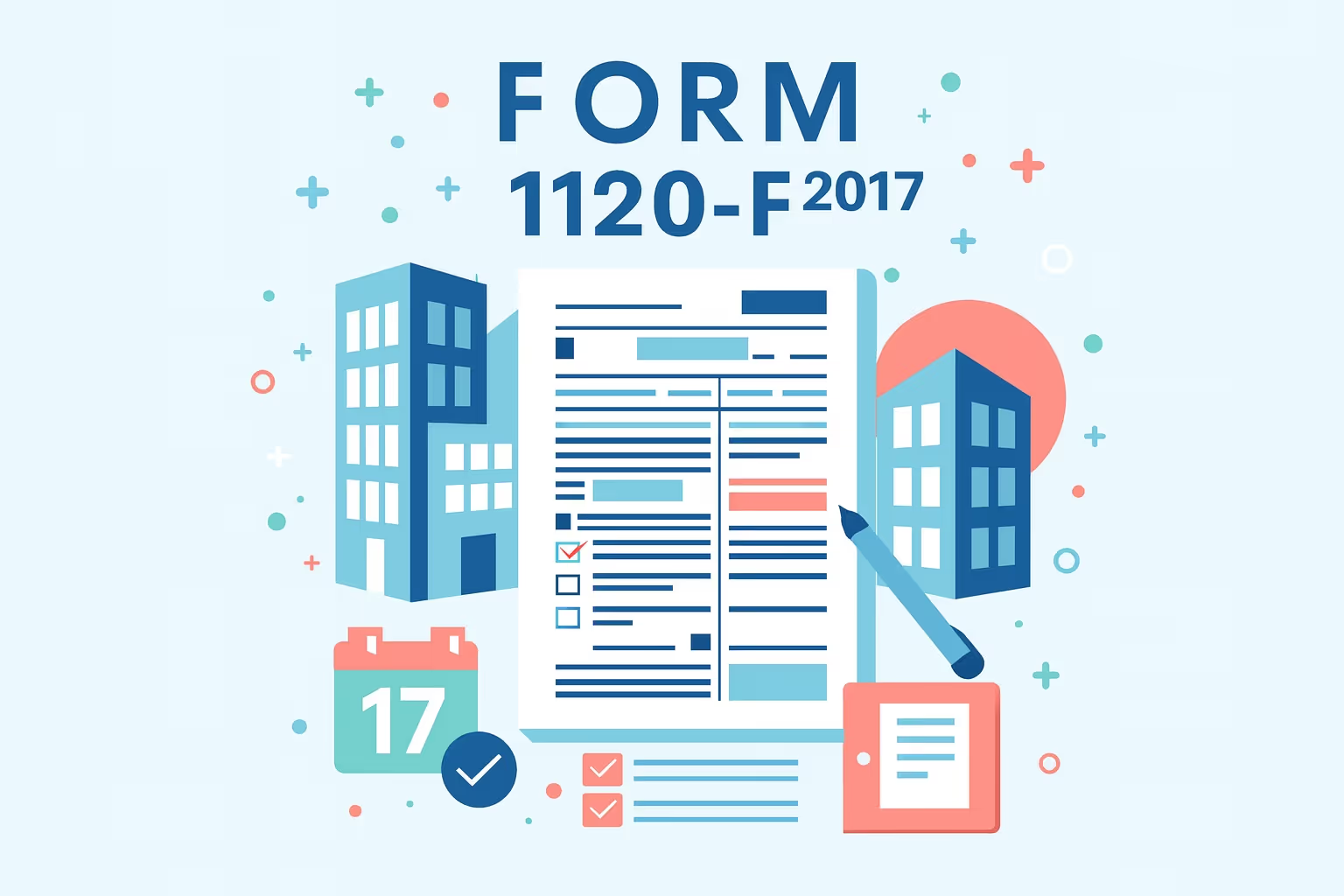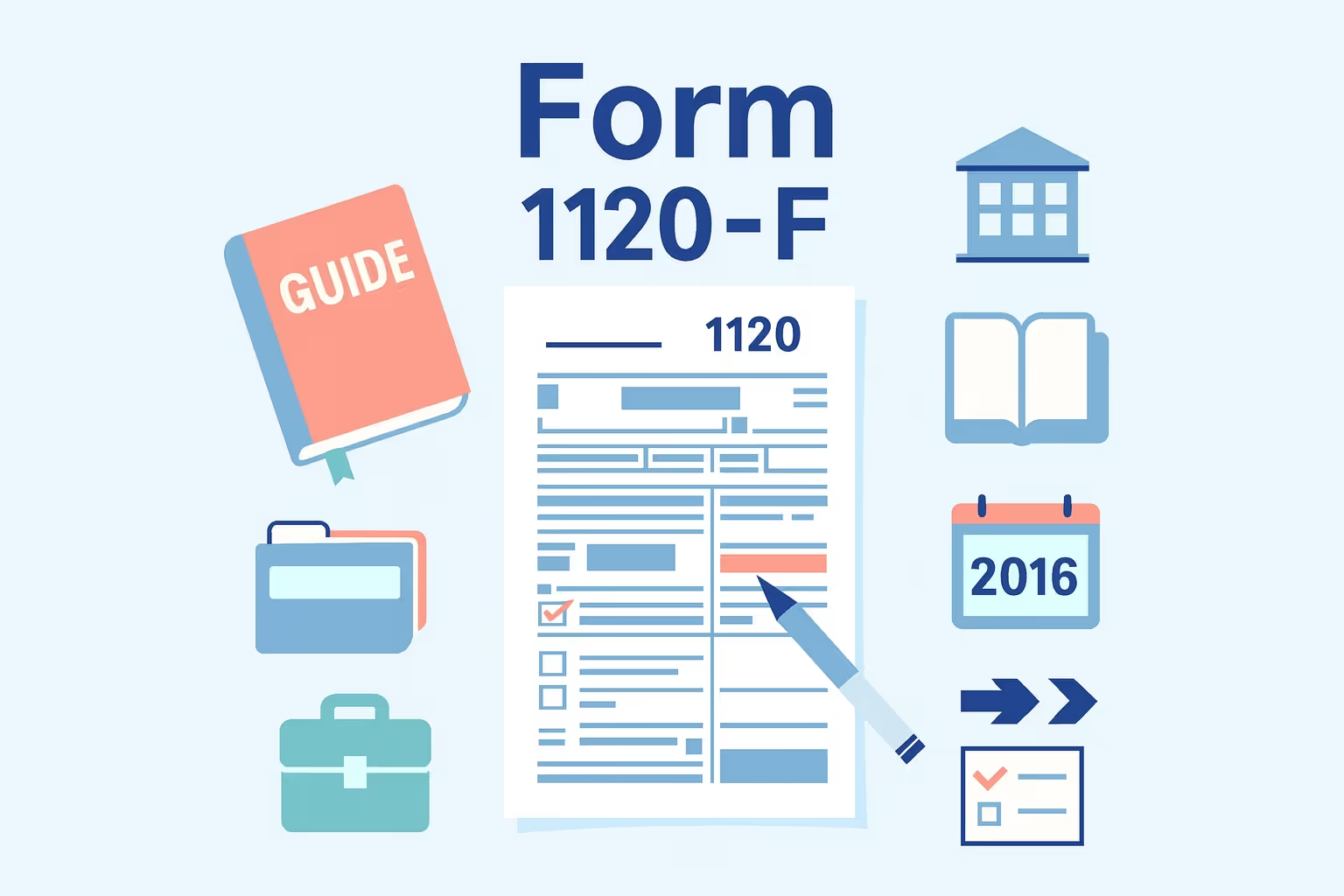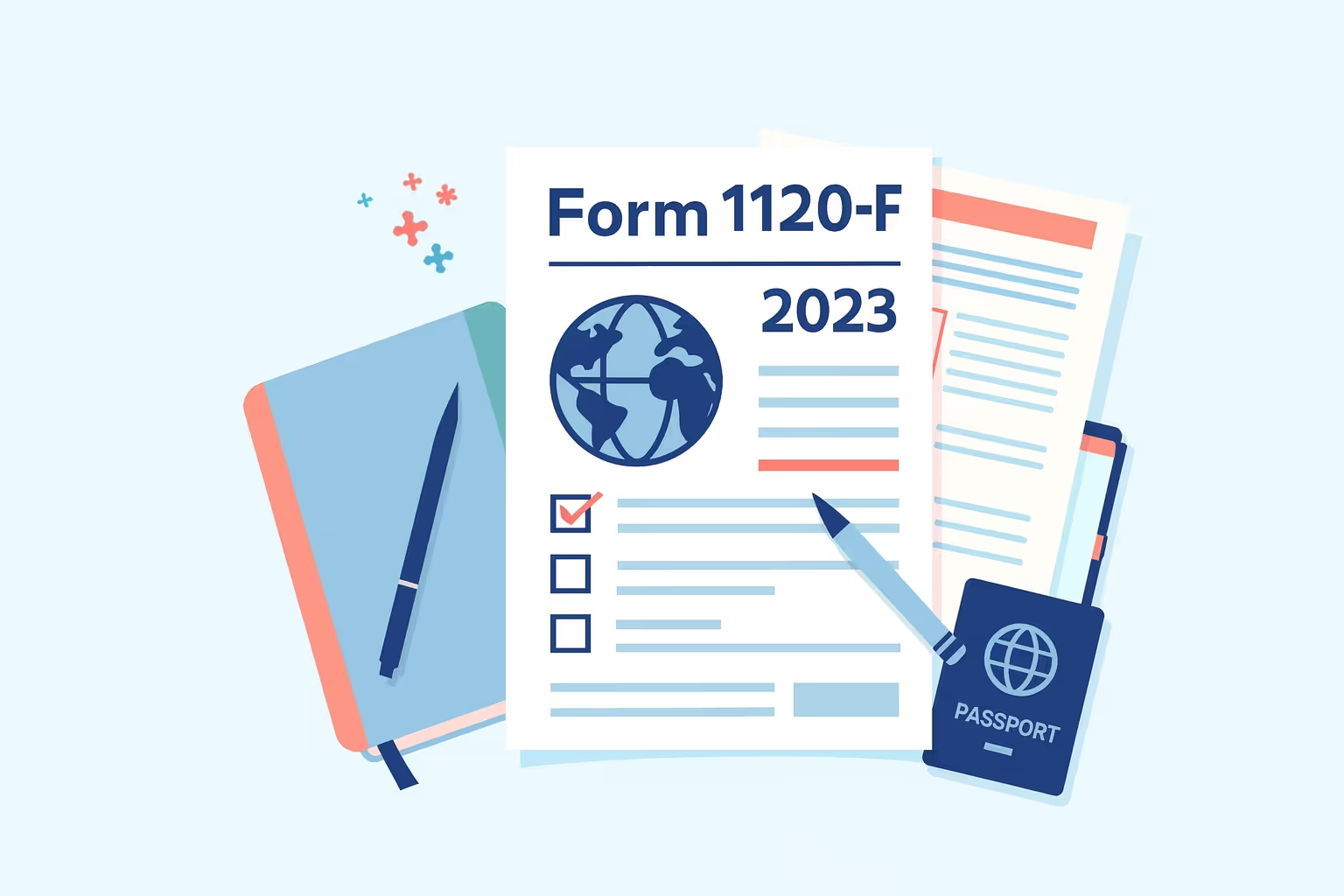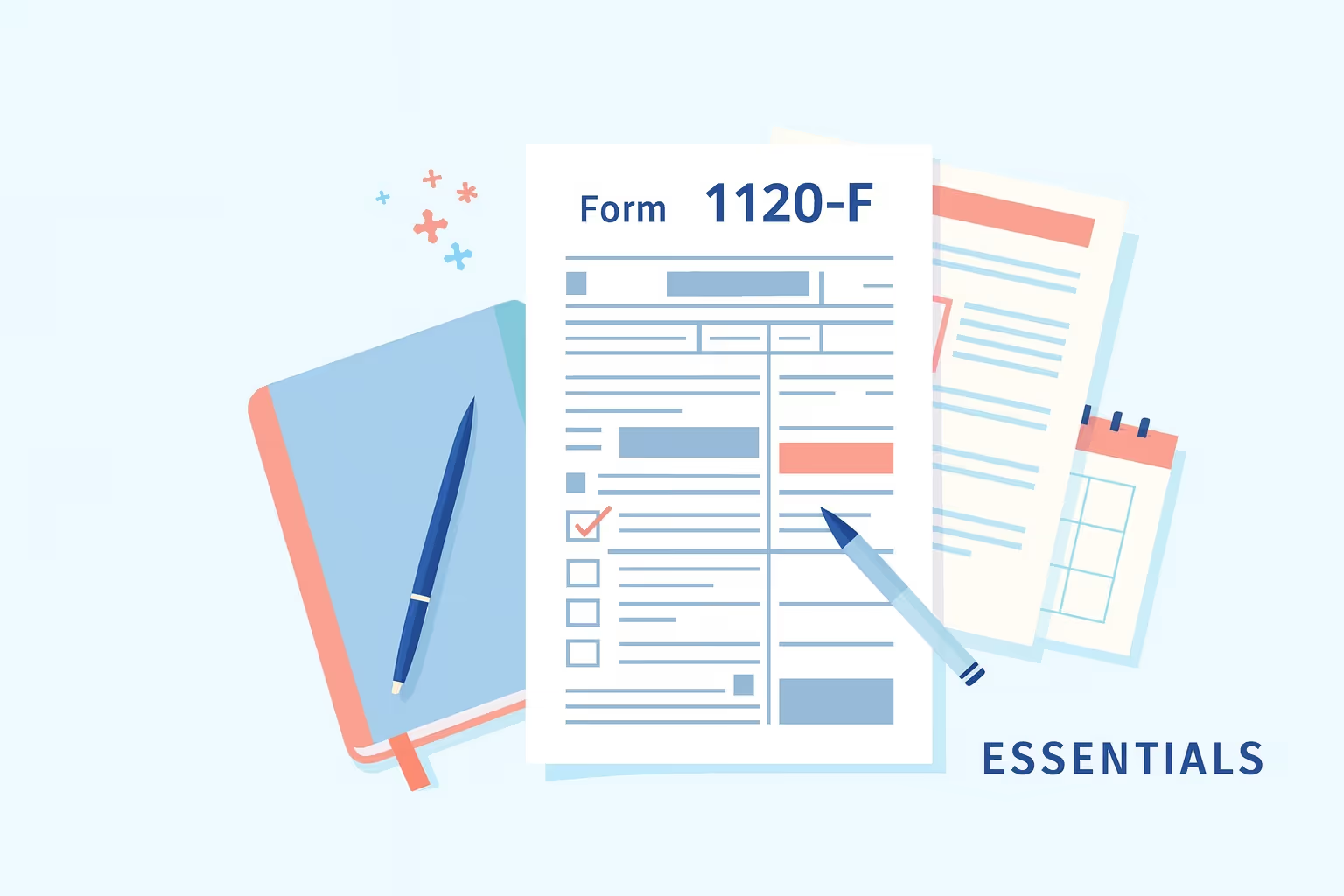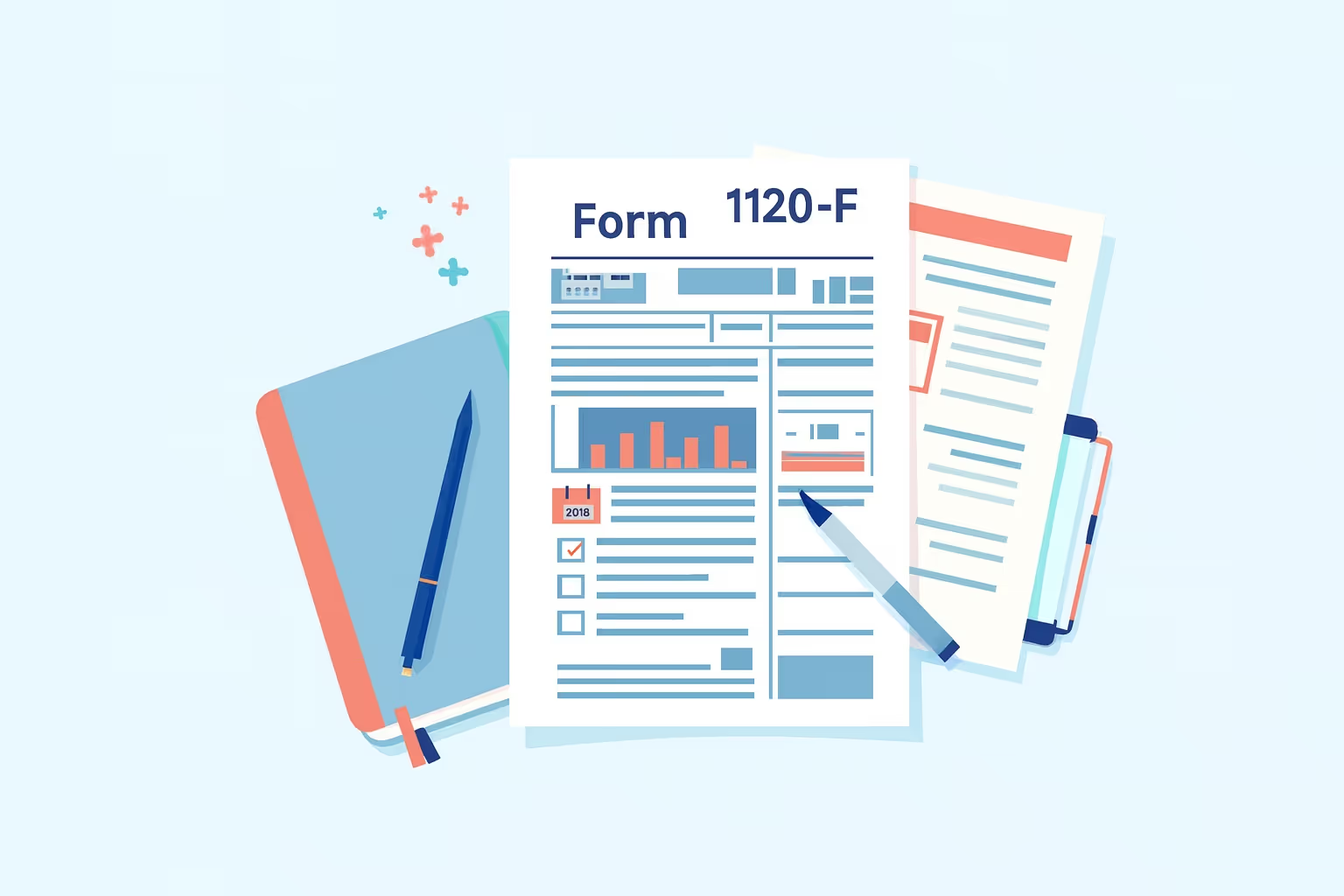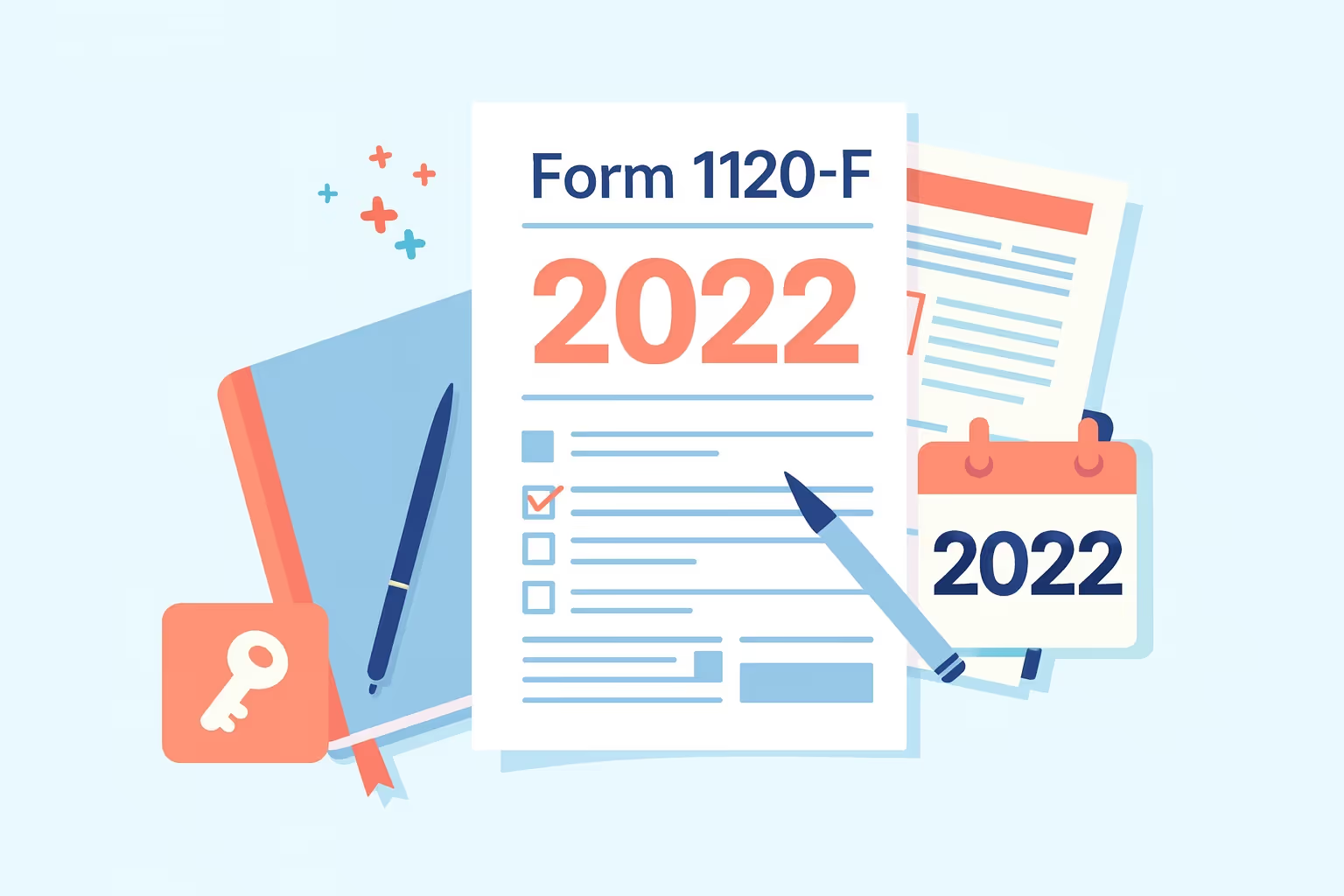Form 1120-F 2015 Instructions: Complete Tax Guide
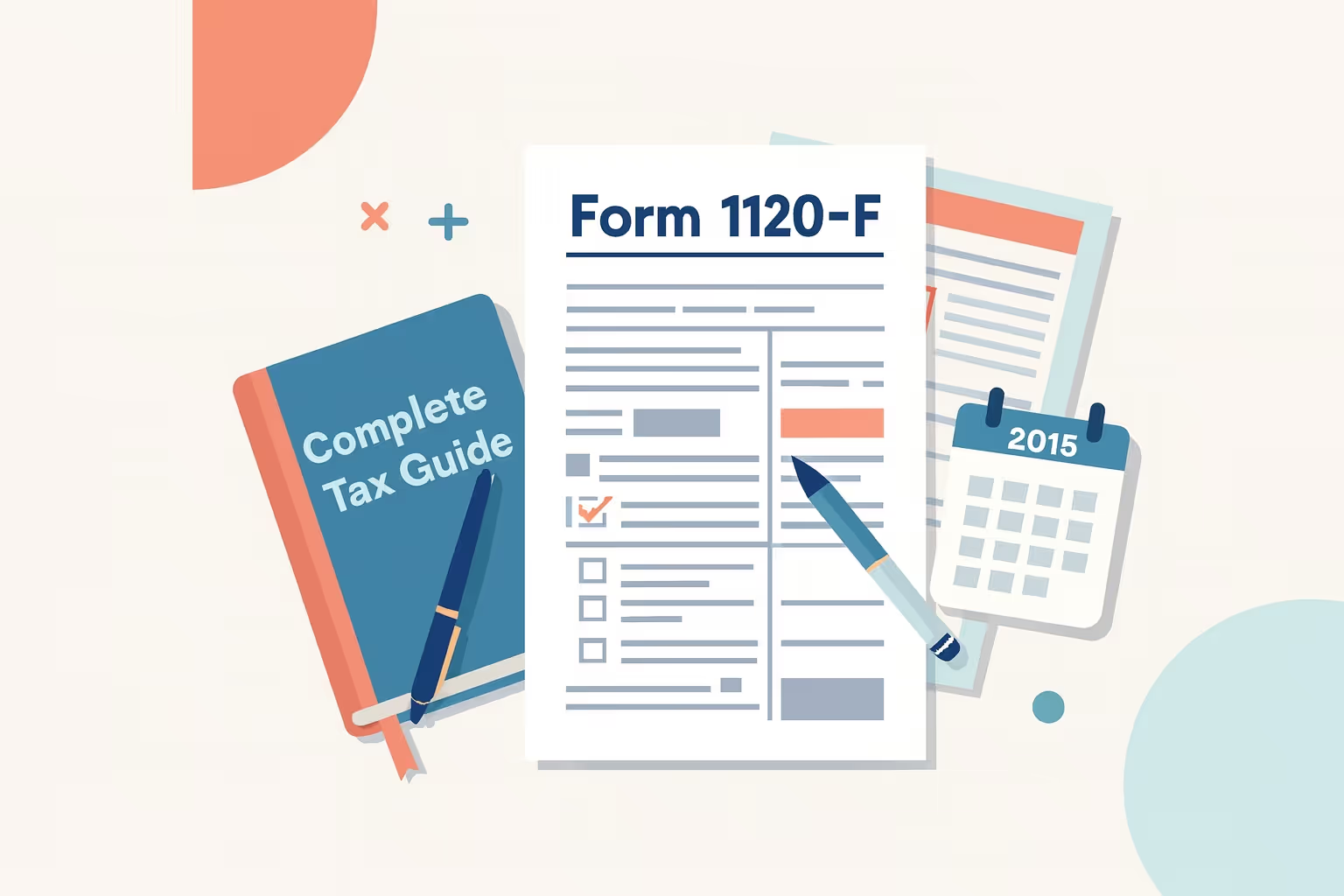
Foreign corporations conducting business in the United States must comply with federal tax filing requirements. The Internal Revenue Service requires Form 1120-F to report taxable U.S. activities. For the 2015 tax year, the form covers effectively connected income, foreign-source income subject to U.S. rules, and special taxes such as the branch profits tax.
An accurate corporation tax return ensures deductions, tax credits, and treaty benefits are applied correctly. It also prevents unnecessary penalties, loss of allowable deductions, and unwanted IRS scrutiny. Compliance demonstrates that the foreign corporation has properly followed the Internal Revenue Code and related regulations for its corporation’s tax year.
This guide provides step-by-step instructions to help foreign corporations prepare Form 1120-F. It explains effectively connected income reporting, gross income classification, and deductions. It also reviews how business income, interest expense, and retained earnings interact with overall tax liability for the corporation tax return.
Overview of Form 1120-F 2015 Instructions
Form 1120-F is the income tax return for corporations that foreign entities use to report gross income, deductions, and tax liability from U.S. business activities.
- Primary purpose: The form documents taxable income for foreign corporations engaged in U.S. trade or business activities during the tax year.
- Income classification: It separates effectively connected income from income subject only to withholding tax for the precise application of corporate income tax rules.
- Tax compliance: Filing ensures adherence to the Internal Revenue Code for domestic and foreign corporations, including alternative minimum tax and other taxes.
- Disclosure items: Form 1120-F requires uncertain tax position statements, schedules, and supporting documentation when claiming deductions or treaty benefits.
- Special focus: The return covers branch profits tax, excess interest, and disclosure of treaty-based exemptions relevant to the foreign country of incorporation.
Foreign Corporation Filing Requirements
A foreign corporation must file Form 1120-F whenever it engages in trade or business within the United States. It still has filing obligations even if it reduces or eliminates its taxable income.
- Business presence: A foreign corporation engaged in effectively connected trade or with a permanent establishment must report gross income and deductions.
- Income subject to filing: Withholding tax on dividends paid, interest, or other income may require filing even without significant business income.
- Deduction claims: Filing is mandatory to claim employment credits, charitable contributions, or a net operating loss deduction against taxable income.
- Refund claims: Corporations must file to receive refunds of excess withholding tax or to apply tax treaty benefits that reduce total tax.
- Exemption disclosure: Even tax-exempt interest or treaty-exempt income requires filing to satisfy the Paperwork Reduction Act notice requirements.
Effectively Connected Income Reporting
Effectively connected income (ECI) must be reported separately from non-business income. Proper classification determines the corporation’s taxable income and total tax liability.
- Definition: ECI is income linked to U.S. trade through the asset use or business activities test under IRS rules.
- Examples: Sales of purchased inventory property, personal services, and income from depreciable assets generally qualify as effectively connected.
- Tax treatment: ECI is subject to corporation income tax return rules, allowing deductions, net operating losses, and general business credit claims.
- Deductions allowed: Corporations may deduct interest expense, employment credits, and charitable contributions from ECI when they compute tax.
- Compliance: Misclassification of gross income or ECI may lead to estimated tax penalty assessments or denial of deductions in prior tax years.
Business Income and Gross Income Distinctions
Foreign corporations must distinguish between business and gross income to comply with IRS reporting requirements. The separation affects taxable income calculation and filing accuracy.
- Gross income: Gross income includes total receipts such as bond credits, dividends paid, rents, royalties, and other income before deductions are applied.
- Business income: The income is effectively connected to business activities, including inventory, property, and real property interests.
- Taxable income: Gross income minus allowable deductions equals the corporation’s taxable income, forming the basis for computing total tax.
- Recordkeeping: Corporations must maintain accurate accounts receivable, retained earnings, and capital assets to support taxable income reporting.
- IRS scrutiny: Inconsistent gross or business income reporting may prompt IRS discussion notices and audit adjustments.
Step-by-Step Filing Instructions
Completing Form 1120-F requires accuracy and full disclosure. Each step ensures gross income, deductions, and tax liability are properly reported for the corporation’s tax year.
Step 1: Gather Required Information
Foreign corporations must gather all relevant records before filing Form 1120-F. These include bank records, partnership agreements, financial statements, and prior tax returns. In addition to withholding tax documents, corporations need inventory property details and schedules. Correctly reporting deductions, tax credits, and effectively connected income reduces filing errors and estimated tax penalty assessments.
Step 2: Complete Corporate Information Section
The return begins with basic identifying information. Corporations must enter their full legal name, Employer Identification Number, and foreign country of incorporation. The IRS also requires the corporation’s tax year, principal business activity, and relevant industry codes. Accuracy at this stage establishes the framework for the entire corporation's income tax return. Errors here may cause IRS discussion notices or filing delays.
Step 3: Complete Section I – Income Not Effectively Connected
Section I reports U.S. source FDAP income unrelated to business activities. Items include dividends paid, royalties, rents, and tax-exempt interest. Corporations must list gross income amounts before deductions and attach withholding tax forms as proof. Proper reporting prevents double taxation, ensures accurate tax liability, and allows foreign corporations to claim refunds or treaty reductions on excess withholding.
Step 4: Complete Section II – Effectively Connected Income
Section II is often the most detailed part of Form 1120-F. It covers effectively connected income derived from U.S. trade or business activities. Corporations must report gross receipts, inventory property purchased, deductions, and allocated interest expense. Net operating losses, employment credits, and charitable contributions may also apply. Careful reporting ensures accurate computation of taxable income and compliance with the Internal Revenue Code.
Step 5: Complete Section III – Branch Profits Tax
Section III calculates branch profits tax, which applies to effectively connected earnings not reinvested in U.S. business assets. Corporations determine dividend equivalent amounts by adjusting net equity, retained earnings, and prior year minimum tax balances. The standard tax rate is 30 percent, but tax treaties may reduce liability. Accurate calculation ensures compliance, prevents excess interest issues, and avoids unnecessary tax assessments.
Required Schedules and Attachments
Schedules verify income, deductions, and compliance. They help the IRS confirm a corporation’s taxable income and prevent errors when filing a corporation income tax return.
- Mandatory schedules: Balance sheets (Schedule L) and reconciliation forms (Schedule M-1 or M-3) show differences between book and taxable income.
- Expense allocation: Schedule H ensures proper deduction assignment between effectively connected income and other income, preventing misstatements of tax liability.
- Interest reporting: Schedule I determines excess interest, debt-financed stock adjustments, and branch-level allocations that affect other taxes under the Internal Revenue Code.
- Partnership income: Schedule P reports effectively connected income from U.S. partnerships, reconciling the corporation’s net income or losses.
- Uncertain positions: Schedule UTP discloses uncertain tax position statements when asset thresholds are met, ensuring transparency and avoiding penalties.
- Treaty disclosures: Form 8833 must accompany tax treaty claims for reduced withholding or branch profits tax relief to support treaty-based return positions.
How to File Form 1120-F
Form 1120-F may be submitted electronically or on paper. Both methods require complete schedules, supporting documents, and proof of income tax liability payment.
Electronic Filing (E-file)
E-file requires IRS-approved providers and digital signatures. It offers faster processing, reduced errors, and quicker refunds for excess withholding tax credits applied against taxable income.
Paper Filing
Paper returns must include signed forms, attached schedules, and supporting certificates. They are mailed to designated IRS service centers, ensuring compliance for domestic and foreign corporations.
Payment Instructions
Tax liability must be satisfied by the required deadlines. Payments must identify the corporation’s tax year and apply to the correct form for proper IRS processing.
- U.S. office corporations: Filing and payment deadlines fall on the 15th day of the third month following the corporation’s taxable year end.
- No U.S. office: Corporations without a U.S. office must file by the 15th day of the sixth month following their corporation’s tax year.
- Electronic transfers: EFTPS allows secure electronic funds transfer for tax liability payments, reducing delays and ensuring compliance with Internal Revenue Code requirements.
- Checks or money orders: Payments to “United States Treasury” must include the corporation’s name, EIN, and tax year for proper crediting.
- Wire transfers: Wire transfers may be used, but corporations must provide bank identification details and clearly indicate that the payment applies to Form 1120-F filings.
Common Mistakes to Avoid
Filing errors increase audit risk and penalties. Accurate reporting of gross income, taxable income, and deductions reduces exposure to IRS enforcement actions.
- Incorrect EIN: Submitting returns with an incorrect EIN delays processing and increases the chance of IRS discussion notices.
- Income misclassification: Mixing effectively connected income with other income inflates tax liability and denies deductions.
- Poor disclosure: Failing to include uncertain tax position statements, treaty disclosures, or supporting documents creates compliance violations.
- Late filing: Missing deadlines without requesting an extension may lead to estimated tax penalties, loss of deductions, and interest charges.
- Expense allocation errors: Improperly allocating interest expense or deductions to effectively connected income reduces allowable offsets and distorts taxable income calculations.
Zero Activity or Dormant Year Guidance
Even corporations with no business activities may face filing obligations. Compliance ensures treaty benefits and deductions are not lost for the tax year.
- Filing required: Inactive corporations with U.S. offices, bank accounts, or treaty claims must still file to satisfy reporting rules under the Internal Revenue Code.
- Exemption filings: Corporations claiming treaty exemptions must file and disclose their positions, even if taxable income equals zero.
- Minimum schedules: Dormant filers should include Schedule L, Schedule M-1, or Schedule M-3 to maintain accurate records for prior tax years.
- Supporting statements: Corporations must attach a clear explanation confirming dormant status, retained earnings, and lack of effectively connected income.
- Compliance safeguard: Filing protects against IRS penalties, ensures proper documentation, and preserves eligibility for tax credits in future tax years.
First-Time Filer Tips
Foreign corporations filing Form 1120-F for the first time must pay careful attention to eligibility, documentation, and compliance. Proper preparation helps avoid penalties and IRS inquiries.
- Obtain EIN: Secure an Employer Identification Number before filing, as the IRS requires this for all corporate income tax return submissions.
- Identify tax year: Choose the corporation’s calendar or fiscal year and remain consistent in subsequent income tax returns.
- Review treaties: Study applicable tax treaty provisions for withholding tax, branch profits tax, or effectively connected income exemptions.
- Assemble documents: Collect prior tax years’ records, debt-financed stock details, and retained earnings statements to support deductions and tax credits.
- Seek expertise: Engage a tax preparer when business activities, controlled foreign corporations, or uncertain tax position statements complicate reporting.
Effectively Connected Income vs FDAP
The IRS divides U.S. source income into effectively connected income and FDAP income. Correct classification is vital for accurate tax liability and deductions.
- Effectively connected income: Derived from business activities like sales of inventory property, personal services, or real property interests. It allows deductions and credits under the Internal Revenue Code.
- FDAP income: Consists of passive items such as dividends paid, bond credits, or royalties. It is generally taxed through withholding tax without deductions.
- Classification tests: The asset use test and business activities test determine whether gross income is treated as effectively connected or FDAP.
- Impact: Misclassification affects taxable income, general business credit eligibility, and net operating loss deductions for the corporation’s tax year.
Treaty Positions
Tax treaties influence how foreign corporations calculate tax liability. Proper filing ensures that reduced rates or exemptions are valid under U.S. law.
- Withholding reduction: Many treaties reduce the withholding tax rate on dividends, interest, and royalties that a foreign corporation pays.
- Branch profits tax relief: Some treaties lower or eliminate the branch profits tax if qualification requirements are satisfied.
- Disclosure rules: Corporations must file Form 8833 to claim most treaty benefits and avoid penalties under the Paperwork Reduction Act notice.
- Qualification standards: Treaty relief often requires proof of residence, ownership percentages, or compliance with limitation on benefits provisions.
- Documentation: Certificates of residency, retained earnings reports, and voting stock evidence are typically needed to validate treaty-based positions.
Branch Profits Tax
The branch profits tax applies to foreign corporations with effectively connected earnings not reinvested in U.S. assets. Its purpose is to equalize treatment with domestic corporations.
- Rate: The tax is 30 percent of dividend equivalent amounts, unless a tax treaty provides a lower rate.
- Calculation: Corporations determine effectively connected earnings, then adjust for changes in net equity, retained earnings, and other income items.
- Treaty relief: Many treaties reduce rates or exempt corporations meeting ownership, voting stock, or permanent establishment conditions.
- Planning strategies: Corporations may increase net equity through reinvestments or deferrals to reduce liability in future tax years.
- Documentation: Records of bonds payable, depreciable assets, and treasury stock help demonstrate compliance in computing branch profits tax.
Frequently Asked Questions
What happens if I file Form 1120-F late?
Late filing may trigger penalties, estimated tax penalties, or interest charges. More critically, a foreign corporation may lose deductions for effectively connected income if not filed on time. The IRS may also increase scrutiny of the return and deny tax treaty benefits. Timely filing ensures compliance and preserves deductions available under the Internal Revenue Code.
Can I amend Form 1120-F after submission?
A corporation may file an amended income tax return using Form 1120-F marked as amended. Amendments are allowed within three years of the original filing deadline. This permits corrections to gross income, deductions, or tax credits. Amending is necessary to claim treaty benefits or refunds of excess withholding tax, ensuring accurate taxable income and total tax liability reporting.
Do I need to file a return if all U.S. income was withheld at the source?
A filing may not be required if withholding tax fully satisfies U.S. liability and no deductions or refunds are claimed. However, filing Form 1120-F is necessary to claim treaty benefits, refund overpayments, or disclose exemptions. Filing also establishes compliance under the Paperwork Reduction Act notice and avoids questions regarding effectively connected income classification for prior tax years.
How do I know if income is effectively connected?
Effectively connected income is determined by applying the asset use test and business activities test. Income linked to U.S. operations, such as inventory property sales, personal services, or depreciable assets, is treated as effectively connected. Proper classification ensures deductions and credits may be applied. Misclassification risks inflated taxable income, branch profits tax errors, and the IRS discusses notices regarding reporting accuracy.
What documentation supports treaty benefits?
To claim treaty benefits, corporations must provide certificates of residency from a foreign country, retained earnings reports, and ownership percentages of voting stock or certain preferred stock. Supporting documents may include treasury stock evidence and prior year minimum tax records. Filing Form 8833 and attaching statements ensures compliance with disclosure rules, avoids penalties, and confirms eligibility for reduced or exempt tax rates.
When is the branch profits tax due for foreign corporations?
The branch profits tax applies when effectively connected net income is not reinvested in U.S. operations. Corporations must calculate net equity adjustments and dividend equivalent amounts. The standard rate is 30 percent, though treaties may reduce it. Records of capital assets, other depreciable assets, and bonds payable must be maintained to compute tax liability. Proper planning strategies may mitigate or defer payment obligations.
















